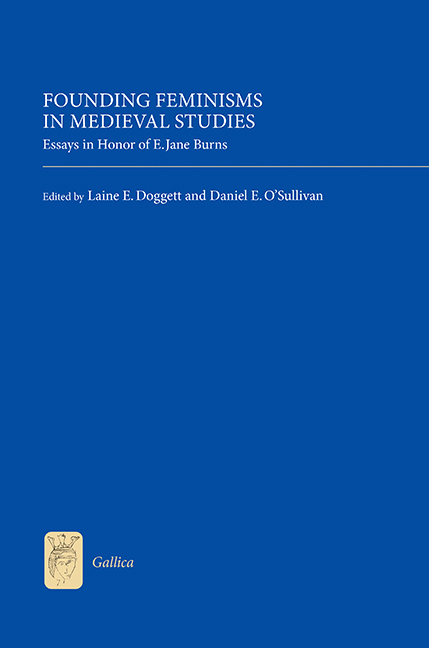Book contents
- Frontmatter
- Contents
- List of Illustrations
- List of Contributors
- Acknowledgements
- Introduction: The Work of E. Jane Burns and the Feminisms of Medieval Studies
- E. Jane Burns: A Bibliography
- Part I Debating Gender
- Natural and Unnatural Woman: Melusine Inside and Out
- Nurturing Debate in Le Roman de Silence
- The Man Backing Down from the Lady in Trobairitz Tensos
- Having Fun with Women: Why a Feminist Teaches Fabliaux
- Part II Sartorial Bodies
- Part III Mapping Margins
- Part IV Female Authority: Networks and Influence
- Afterword: A Response to the Volume
- Index
- Tabula Gratulatoria
- Already Published
Nurturing Debate in Le Roman de Silence
from Part I - Debating Gender
Published online by Cambridge University Press: 05 July 2016
- Frontmatter
- Contents
- List of Illustrations
- List of Contributors
- Acknowledgements
- Introduction: The Work of E. Jane Burns and the Feminisms of Medieval Studies
- E. Jane Burns: A Bibliography
- Part I Debating Gender
- Natural and Unnatural Woman: Melusine Inside and Out
- Nurturing Debate in Le Roman de Silence
- The Man Backing Down from the Lady in Trobairitz Tensos
- Having Fun with Women: Why a Feminist Teaches Fabliaux
- Part II Sartorial Bodies
- Part III Mapping Margins
- Part IV Female Authority: Networks and Influence
- Afterword: A Response to the Volume
- Index
- Tabula Gratulatoria
- Already Published
Summary
Despite its title and emphasis on the value of holding one's tongue, Heldris de Cornuälle's thirteenth-century Le Roman de Silence has inspired anything but silence on the part of medievalists for the past two decades. To be sure, the romance seems tailored to today's audience. Scholars and students alike are drawn to the story of the world's most beautiful baby girl, who is raised as a boy for inheritance purposes, becomes the King of England's most loyal and talented knight, emerges unscathed from the queen's vindictive attempts to bring about Silence's permanent exile or death, and eventually weds the sovereign to become queen herself. Still, the plot alone does not explain the tale's appeal. Equally important are the myriad questions that the text raises but never answers conclusively. Who was Heldris de Cornuälle – and, the designation of “Maistres” notwithstanding, was Heldris a man or a woman? Do two references to Arthur and the late arrival of Merlin suffice to qualify the romance as Arthurian?3 Is the tale ultimately misogynistic, transmitting an ultra-conservative message, or does it reveal more radical, proto-feminist tendencies? If the latter, does Heldris espouse this viewpoint, or does it result despite attempts to prove women's “natural” inferiority?
These questions are not merely imposed by twenty-first- century critics looking at the romance through modern eyes. Rather, they are built into the text itself. That is, the storyline and the tale's presentation repeatedly call our attention to these issues – and to their lack of definitive resolution.5 In fact, the ambiguity in Le Roman de Silence adds immeasurably to its interest: the unanswered, and perhaps unanswerable, questions invite discussion. The narrator, who consistently sends mixed messages, plays a key role in this process. From beginning to end, Heldris-the- composer employs varied strategies to shape a narrator who guarantees that the romance will inspire controversy. Ambiguous portraits of characters – whose actions often undermine the qualities for which the narrator praises them – blanket statements condemning an entire group, and narratorial contradictions from one statement to the next render impossible any straightforward interpretation of the tale. The complex characters and diverse perspectives that result from these approaches encourage audience members to draw their own conclusions, ensuring that the debates within the romance will provoke dialogue extratextually well after Le Roman de Silence concludes.
- Type
- Chapter
- Information
- Founding Feminisms in Medieval StudiesEssays in Honor of E. Jane Burns, pp. 33 - 44Publisher: Boydell & BrewerPrint publication year: 2016



